How To Get A Mini Donkey Registered As A Therapy Animal
What makes a mule different from a horse?
First, let's clarify what a mule is. A mule is the offspring of a male donkey (a jack) and a female horse (a mare). A horse has 64 chromosomes, and a donkey has 62. The mule ends up with 63. Mules can be either male or female, but, because of the odd number of chromosomes, they can't reproduce. However, a male mule should be gelded in order to make him a safe and sociable animal.
Except for the long ears, mules look very similar to horses, but their muscle composition is different. Mules have smoother muscles than horses. Think of a football player's muscle build compared to that of a ballerina's. Both are very strong, but the mule has greater physical strength for its size, and more endurance. A mule gets its athletic ability from the horse and its intelligence from the donkey. Donkeys and mules have been labeled "stubborn" for centuries, but it is really only an abundance of common sense and a strong desire for self-preservation that might make them inclined to resist. Mules and donkeys actually have a natural attraction to humans. When treated with patience, kindness and understanding, they learn to trust and obey. If they are treated with force and abuse, they are not likely to comply with your wishes. If only a mule could talk, most people would be surprised at how smart they really are!
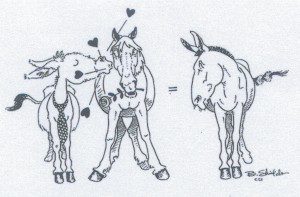
What does the name "mule" mean?
The word "mule" can be used for any hybrid, and is a cross between two species of equine: the horse or pony (Equus caballus) and the domestic donkey (Equus asinus). The term "mule" is used for either the cross of male donkey on female horse, or the cross of female donkey on male horse, although the latter cross is more correctly known as a "hinny." Mules and hinnies each have one horse and one donkey parent, however the two crosses generally differ from each other in appearance and stature, and—to some extent—temperament.
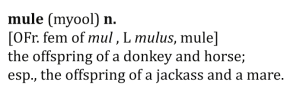
What is the history of mules in the United States?
In addition to being the father of our country, George Washington was an enlightened agriculturalist—a visionary who, early on, saw the true value of the mule. But right from the beginning, he faced a major obstacle. At the time, the Spanish Government prohibited acquisition of the legendary Andalusian donkey. However, in 1785, King Charles III of Spain presented Washington with a gift of two jacks and two jennets. One of the jacks died during the voyage, but the survivor, named Royal Gift, went on to sire an American dynasty that reshaped the very landscape of this country. But with the advent of engine-powered vehicles, the mule's once-critical role in agriculture and industry diminished. It's estimated that, by the late 1960s, fewer than 10,000 mules existed in the United States, and many of those languished—unused, unnoticed and in danger of fading from our culture altogether.
But a handful of mule and donkey lovers were determined to keep that from happening. Among them were Paul and Betsy Hutchins who, in 1967, founded the American Donkey and Mule Society, an organization dedicated to the protection and understanding of longears. They also publish The Brayer, a bi-monthly magazine with an international subscriber base. Mules and donkeys have enjoyed resurgent popularity during the last 40 years. Today, annual events such as Bishop Mule Days in Bishop, Calif., host more than 30,000 people and 700 mules. Mule events, stock shows, trade publications and even television programs like Meredith's series, Training Mules and Donkeys, continue to foster interest in these amazing animals.

What are the common sizes of donkeys or mules?
Division by size rather than breed is due to unclear ancestry in the New World. Donkeys were turned loose by explorers and interbred.
Donkeys:
| Mules:
|
| Miniature Donkeys | Miniature Mule |
| Small Standard Donkey | Large Standard Donkey |
| Standard Donkey | Standard Mule |
| Mammoth Donkey | Draft Mule |
What are mules and hinnies?
The mule is a hybrid cross between a male donkey (jack ) and a female horse (mare). Because the mule most often demonstrates the best traits from each parent, he possesses what we call hybrid vigor. The mule inherits from the donkey his incredible strength, intelligence, patience, perseverance, endurance and surefootedness from the jack and his equine beauty, athletic ability and speed from the horse.
The hinny, or hinney, is also called a mule. However, the hinny is the hybrid cross between a male horse (stallion), and a female donkey (jenny, or jennet). The hinny is different from a mule in very subtle ways. For instance, the hinny is a somewhat slower and more meticulous mover than the mule. He inherits his way of going from the jennet as does the mule, which tends to be a little faster, more energetic and more agile—like the mare. The hinny, because of his meticulous way of going, is actually better in very steep, rocky terrain and, especially, in loose rock, and will not tire as quickly as a mule. Gaited hinnies are preferable in this kind of terrain where there is little opportunity to gallop because they have a smooth, more ground-covering gait.
The hooves of a hinny tend to be more donkey-like—narrow, oval and more upright—where the hooves of a mule will look more horse-like; a little rounder (although still oval), with slightly more angle than the donkey hoof, but not as flat, round and angled as the horse's hoof. On both hinnies and mules, the hooves should be trimmed more upright and the heels should be left longer than the hooves of the horse.
The hinny will also eat a variety of different kinds of shrubs and bushes to sustain himself, where a mule will be more selective, again because of the influence of the female parent. This makes the hinny more desirable to those people living in remote mountain areas with little vegetation.
Both the mule and the hinny have more endurance by far than the horse, and are more resistant to parasites and disease, require less feed for good health, have tougher hooves than the horse, and have an incredible sense of self preservation that keeps them safe, which is often mistaken for stubbornness. The horse has a flight reflex when startled and the donkey has a freeze reflex; mules and hinnies can exhibit both the freeze and flight reflexes, depending on their own unique personalities and the situation at hand.
When breeding for mules, since the jacks are generally smaller and of slighter build than a horse, mule foals are generally smaller than horse foals and the mare has very little problem foaling. When breeding for hinnies, one needs to be cautious, as the jennets are smaller and of a slighter build than mares. A large stallion could produce a foal that would be too large and difficult for the jennet to easily foal. Matching the size of the parents is much more important with hinnies. It is more difficult for a jennet to settle after being bred to a stallion than it is for a mare to settle after being bred by a jack, so breeding for hinnies can take significantly longer.
What kinds of hybrid equines are there?
Horses, Mules and Donkeys
- Stallion: male horse
- Mare: female horse
- Jack: male donkey
- Jennet or Jenny: female donkey
- Horse mule, john mule: male mule
- Mare mule, molly mule: female mule
Horse, Mule and Donkey Hybrids
- Mule: donkey father + horse mother
- Hinny: horse father + donkey mother
- Donkule, jule: donkey father + mule mother
- Hule: horse father + mule mother
Zebroids (Zebra Hybrids)
- zedonk, zebrass, zebronkey, zonkey, zebonkey, zebadonk, zebryde:zebra father + donkey mother
- zorse, golden zebra, zebra mule, zebrule:zebra father + horse mother
- zony:zebra father + pony mother
- zetland:zebra father + Shetland pony mother
- zebret, donkra:donkey father + zebra mother
- hebra, horbra, zebrinny:horse father + zebra mother
A hinny resembles a horse more than it does an ass. It looks more like a horse with long ears and looks very much like a mule. The hinny has been used as a saddle animal from antiquity and is more difficult to produce than the mule, because the jennet does not conceive well with the stallion.
Certain breeds of mares do not conceive as well with the jack as other breeds.
Although hybrids are typically sterile, two documented cases of fertility do exist. One was known as Old Beck from Texas A&M, bred first by stallion, Pat Murphy, and yielded the hule, Pat Murphy, Jr. She was bred a second time to a jack and produced the jule, or donkule Kate. The other was Krause, belonging to Arthur Silvester in Champion, Nebraska. She was bred to a jack twice and foaled first with Blue Moon, and then with White Lightning. More numerous cases have emerged with the new technology and better national and international communication.
Mules are also used in the equine industry for embryo transplants.
There are no documented cases involving fertile male mules.
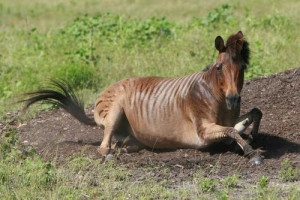
Zorse, photo courtesy Tsaag Valren

Zebroid, photo courtesy Christine and David Schmitt
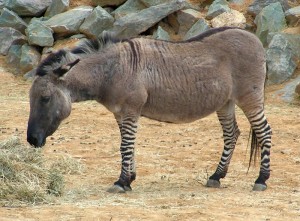
Zedonk, photo courtesy Wikipedia user Sannse
What are the physical characteristics of the Ass?
- A distinctive bray.
- Long ears.
- Short, upright and thin mane.
- Hair only on the end of its tail.
- Tends to look more horse-like.
- May come in a variety of colors.
- Hooves are narrow and box-like, unlike the horse's hoof. They're upstanding, and made for rock and mountain climbing. They are tough and elastic, non-chipping and can grow to long lengths when the animal is on soft ground and the hooves are left untrimmed.
- Long body with long, wiry muscles.
- Short and straight back. Lacks upstanding withers and is excellent for packing and weight bearing.
- Bone is dense and hard.
- Gestation is 12 months, whereas the gestation period for a horse is 11 months.
- Usually has a white belly and muzzle, and circles around the eyes.
- Colors are much like that of a horse.
- They can come in more colors than a horse, even an Appaloosa.
- Mule's conformation falls somewhere in between that of the donkey and that of the horse.
- Mules inherit best traits from both its sire and its dam.
- Mules get their athletic ability from the horse, while strength and intelligence come from the donkey.


What are the mental characteristics of the Ass?
- Highly intelligent, alert, curious and affectionate, when not worn down by bad conditions (i.e., cruel treatment, bad shelter, bad food and water or overwork).
- Quick to learn. A well-trained mule is calm, tolerant, loyal, affectionate, obliging and patient.
- Sensitive. Mules and donkeys might be mistaken as being stubborn when they're actually afraid or confused.
- Has common sense and not prone to panic or carelessness.
- Can recognize danger.
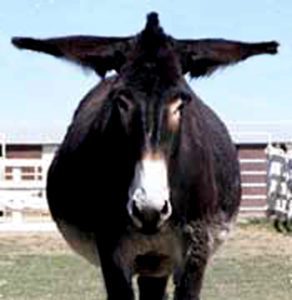
Where are donkeys and mules registered?
Is training a mule different from training a horse?
Sometimes, horse training techniques will work on mules and donkeys that are of a certain mellow personality type, but they are the exception rather than the rule. Most mules require a kind, polite, sensible, logical and sequential way of training with consideration, consistency and respect for the animal. They are far too intelligent to simply be forced or coerced into behaving. Horses allow behavior from humans that is not always in their best interest, but because of the mules' (and donkeys") increased intelligence and sense of self-preservation, mules simply will not stand for things they perceive as nonsense. When you try to make them do things that don't feel good and don't make sense, you can be faced with incredible resistance. That is why so many trainers that try to use "horse" techniques with mules and donkeys wind up going "skiing" on the end of the lead rope or have out-of-control runaways under saddle and become totally frustrated. Training Longears is easy if you just slow down, take your time and break things down into logical, sequential and doable steps that address not only what you want to do, but how to build and condition his body properly so he can do what you want more easily through the training process. Longears comply when it feels good and is safe to do so. If you are thorough in the early stages of training and take your time, the later stages of training will go much faster.
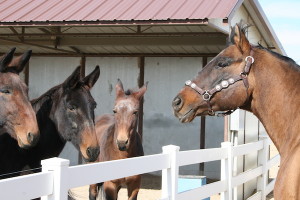
Are mules and donkeys good therapy animals?
There is a lot we can learn about ourselves and the way we communicate with others through interaction with animals in general and with equines in particular. For instance, their uses in therapeutic riding programs for the disabled generate amazing results and enhance the lives of people who might otherwise give up on life. There are measured physical improvements that take place as well as mental and emotional changes. This is why they are also helpful in teaching young people how to interact in a positive and engaging way in their families and communities. The therapeutic riding program, Hearts and Horses (that I strongly support here in Colorado) has expanded their program for the disabled to also include at-risk kids, the autistic, wounded warriors and kids in general through an equine summer camp. Mules and donkeys are able to carry more weight proportionately than can a horse of the same size. Where side walkers are needed in the case of larger people during therapy, smaller mules and donkeys are a better choice than a taller horse that would put the rider in a position that is harder to reach by the side walkers. Horses and other equines (particularly mules and donkeys) that are used in these types of programs truly give people a full and rewarding life. Exposure to equines inspires people about life and exotic hybrids bred from mules and donkeys command even more attention to these types of animals and the lifestyle they represent.
Should I send my mule or donkey to a trainer?
Many people make the mistake of sending their mule to trainers who use abbreviated training methods. These people most often wind up with problems. Mules and donkeys do much better when they are trained in a logical and sequential fashion, taking the right approach and being willing to allow adequate time at each phase of training. The training should be done by the owner and only guided by the trainer for the best results. After all, you wouldn't ask someone to go out and make a friend for you, would you? Training should start with mules and donkeys the day they are born and should continue through their lives as a day to day routine…much like raising children. You don't need to "train" every day, but you do need to be consistent and calculated about what you do with them as their "parent."
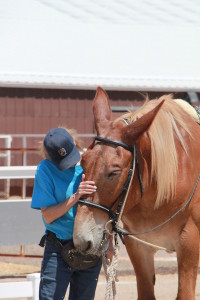
How much weight can my mule or donkey carry?
Mules and donkeys can carry proportionately more weight than a horse of the same size. However, you do need to be careful about making broad generalizations. Obviously, a horse, or mule, who is out of condition is not going to be able to carry as much weight as one who is conditioned properly, so it is all relative to the situation. The maximum weight a horse or mule can carry will depend on a lot of variables. Generally speaking, a mule, or donkey, can carry more weight than a horse because of the unique muscle structure of the animal. However, an equine that is not conditioned properly will not be able to efficiently carry as much weight as one who is. Also, the rider with better balance and riding ability is going to be easier for the equine to carry than one who is not balanced regardless of the difference in actual weight. The size of the equine and the proportion of the equine to the rider will also affect balance and carrying ability.
The amount of weight an equine can comfortably carry or pull depends on many things beginning with the animal's overall fitness. If he is fit, he will be able to carry more than those who are not, but conformational abnormalities will also have an effect. If he has any deviations in his bone structure (i.e. crooked legs), it can compromise how he moves and put undue stress on certain areas depending on the defect. The easiest way to test for weight tolerance is to watch the way the animal moves. If he is halted and seems to be have difficulty moving, the weight is obviously too heavy. If he is unable to trot, or is resistant to trotting, the weight is too heavy. This would be the same in harness. If he cannot move freely, the load is too heavy. So, it's not just a matter of how old he is, but rather how he is conformed and how fit he is at any given stage of training and the weight and ability of the rider that will dictate how much he can carry, or pull. There have never been any real in depth studies on this issue, so the statistics you hear about are not exact, only speculation. Be careful about generalizations because there are always hidden variables to be considered. In addition, fitting saddles can become an issue as your equine changes shape with conditioning, so it is best to fit the saddle when your equine is in good condition.


How To Get A Mini Donkey Registered As A Therapy Animal
Source: https://www.luckythreeranch.com/lucky-three-ranch-training/mule-facts/
Posted by: pendletonplebadve.blogspot.com

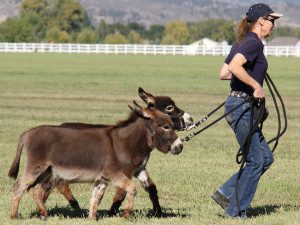

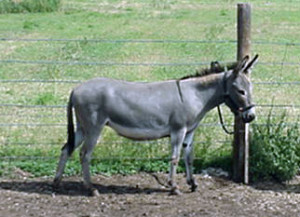

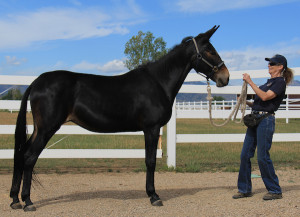
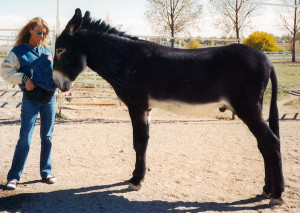

0 Response to "How To Get A Mini Donkey Registered As A Therapy Animal"
Post a Comment